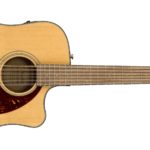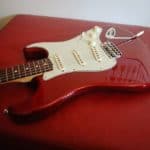For the longest time, players had to make do with 21 and 22-fretted guitars, needing to bend their way to a second octave on the high E string.
24-fret necks eventually came along and allowed the nimblest of shredders access to that range, and more, with the greatest ease! But, as good as it is, it’s not everyone’s cup of tea.
24 frets do give you the benefit of a two-octave range on each string, which may be desirable for some players. The placement of the neck pickup also yields a slightly brighter sound with a touch more attack compared to its 22-fret brethren. Whether or not this is a good thing, however, is completely up to the player and their needs.
So, are they better or not?
Let’s look at the pros and cons, and see if they help you decide.
What’s the standard number of frets on most guitars?
The number of frets on most guitars varies slightly between 21 and 22 frets.
Newer Fender guitars typically have 22, while older models will have 21 frets.
Gibson electrics will typically have 22 frets. Other manufacturers will typically land somewhere in there, though some companies (such as PRS, Ibanez, and Jackson) will offer guitars with 24 frets, giving each string a two-octave range.
With this, it is safe to say that the standard is 22 frets on your typical electric guitar.
(Some guitars, such as the Sky Guitar used by Uli Jon Roth, cap out at 30 frets! Now that’s some screeching range!)
And, to borrow from Monty Python, 23 is right out!
Are guitars with 24 frets better?
Better or not? Who knows! It’s purely up to you. 24 frets do offer the player a chance to hit a few extra notes (want to bend to a high F#? 24 frets makes that easy!).
However, they do come with some trade-offs that can make or break the deal for you.
Most of this comes from the placement of the neck pickup, which the longer neck does affect. This makes a 24-fret guitar good for some things, while unideal for others.
For perspective, Steve Vai and John Petrucci have always used 24-fret guitars and got a great sound. On the contrary, and staying in the same realm, Yngwie Malmsteen and Steve Morse use guitars with 22-fret necks and also got a great sound.
Some other players (the thousands of strat, tele, Les Paul, etc. players who would not use a 24-fret neck by nature of the fact that the manufacturer doesn’t make them) get along just fine without them.
Reasons why guitars with 24 frets are great
First off, two more frets! Each string has a two-octave range that is easy to hit without making bends off the 22nd fret. Also, as previously mentioned, bending off the 24th fret does make notes like a high F#, or even a high G, much easier.
The other thing to consider is the placement of the neck pickup. With 24 frets, the neck pickup will be placed a bit further back towards the bridge, compared to where it would be on a regular 22-fret neck.
Neck pickups tend to have a warmer sound, which for the most part has to do with their placement on the body.
Moving the pickup away from the bridge reduces brightness and attack, making the pickup sound fatter.
Having the pickup a bit closer to the bridge, even just a little bit, can add some of that attack back into the sound.
This added attack and brightness may give you the neck pickup sound you’re looking for, along with the added range! That’s a twofer!
Reasons to avoid guitars with 24 frets
The biggest reason that most players may actively avoid 24-fret necks has to do with one factor, the placement of the neck pickup.
The typical neck pickup tends to be located where the 24th fret would be, which is one of the strong harmonic points on the string (try it! you’ll get a two-octave harmonic at that point, much like at the fifth fret.)
This is a huge source of harmonic content on the string, as well as a big part of the reason why bridge pickups on certain guitars (strats and teles, notably) sound the way they do.
Jazz players in particular love that warmer sound on the neck pickup; having it anywhere other than that sweet spot over the harmonic point just won’t sound the same.
Can you put a 24-fret neck on a 22-fret guitar?
The short answer is yes. However, there is a big BUT after that yes.
The topic was covered in a previous article here:
But to summarize, adding a neck is possible, however, you need to consider a couple of things.
First off is the 12th fret. Guitars come in different scale lengths (24.75” for Gibson, 25.5” for Fender).
The scale length refers to the length of the string from the saddle to the nut. The 12th fret on your neck needs to be at the halfway point for it to be in tune, and the other frets are spaced accordingly.
If you add a neck, you will need to ensure that the distance between the 12th fret and the nut, and the 12th fret and the saddles, is the same.
If not, you’ll run into major intonation problems and your guitar will never play perfectly in tune.
You could remedy this by making adjustments to the neck pocket to make it deeper, allowing you to put that 12th fret in the right spot.
However, unless you’re good with tools and know exactly what you’re doing, you risk doing major and potentially irreversible damage to your instrument.
So, what’s the solution? Well, the easiest thing to do is to purchase an instrument with 24 frets. It’s always nice to have a bit of variety, and who doesn’t want more guitars!
But, unless you want to delve into some Vai-trucci style of playing, or you’re a fan of those classic sounds, your 22-fret necks will do just fine!

Hello there, my name is Ramiro and I’ve been playing guitar for almost 20 years. I’m obsessed with everything gear-related and I thought it might be worth sharing it. From guitars, pedals, amps, and synths to studio gear and production tips, I hope you find what I post here useful, and I’ll try my best to keep it entertaining also.





